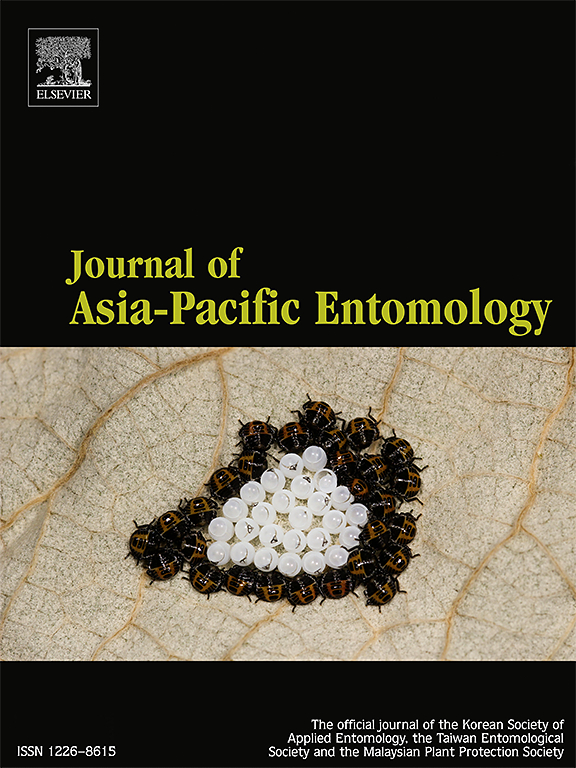Comparing organophosphate and pyrethroid resistance levels of Aedes aegypti (Diptera: Culicidae) in frequent and infrequent application areas of Taiwan
IF 1.3
3区 农林科学
Q3 ENTOMOLOGY
引用次数: 0
Abstract
Aedes aegypti mosquitoes spread a number of diseases that cause significant impacts to public health. In Taiwan, Ae. aegypti are mainly controlled using chemical insecticides, but previous studies indicate that Ae. aegypti may have developed resistance to several insecticides. We hypothesized that Ae. aegypti resistance levels could be affected by insecticide application frequencies and therefore compared transcriptome information, expressions of metabolic resistance genes, and gene mutations of field adult mosquitoes collected from Kaohsiung City (frequent application area, insecticides applied once a week) and Tainan City (infrequent application area, insecticides applied only when dengue cases were discovered); a laboratory strain was established as control. Next-generation sequencing was used to identify potential resistance genes from four main detoxification categories, bioassays were used to determine knockdown effects and mortality rates, and point mutations relating to target resistance were further analyzed. A total of 50 detoxification differential transcripts were identified following comparison with the laboratory strain, and more differential transcripts were found in mosquitos collected from the frequent application area (Kaohsiung). Mosquitoes from areas with frequent applications displayed lower mortality rates, confirming a difference in resistance levels. Additionally, mosquitoes from frequent application areas showed higher levels of resistance to pyrethroids compared with organophosphates. We found silent mutations at G923, L982, and A1007, as well as point mutations at S989P, V1016G, F1534C, and D1763Y. V1016G occurred in all four strains we collected, indicating that pyrethroid resistance in Ae. aegypti has begun to develop in all regions.

台湾常用药区与非常用药区埃及伊蚊(双翅目:库蚊科)对有机磷和拟除虫菊酯的抗性比较
埃及伊蚊传播多种疾病,对公共卫生造成重大影响。在台湾,Ae。埃及伊蚊主要使用化学杀虫剂进行控制,但先前的研究表明,伊蚊在埃及境内的数量较少。埃及伊蚊可能对几种杀虫剂产生了抗药性。我们假设Ae。对高雄市(频繁施药地区,每周施药1次)和台南市(不频繁施药地区,发现登革热病例时才施药)现场成蚊的转录组信息、代谢抗性基因表达和基因突变进行比较,分析了不同施药频率对埃及伊蚊抗性水平的影响;建立了一株实验室菌株作为对照。新一代测序技术用于鉴定四种主要解毒类别的潜在抗性基因,生物测定技术用于确定敲低效应和死亡率,并进一步分析与目标抗性相关的点突变。与实验室菌株比较,共鉴定出50个解毒差异转录本,在高雄疫区蚊虫中发现更多差异转录本。来自频繁使用杀虫剂地区的蚊子显示出较低的死亡率,证实了抗药性水平的差异。此外,来自频繁施药地区的蚊子对拟除虫菊酯类杀虫剂的抗性高于对有机磷杀虫剂的抗性。我们在G923、L982和A1007位点发现了沉默突变,在S989P、V1016G、F1534C和D1763Y位点发现了点突变。采集到的4株伊蚊均出现V1016G,表明伊蚊对拟除虫菊酯类杀虫剂产生抗性。埃及伊蚊已开始在所有地区发展。
本文章由计算机程序翻译,如有差异,请以英文原文为准。
求助全文
约1分钟内获得全文
求助全文
来源期刊

Journal of Asia-pacific Entomology
Agricultural and Biological Sciences-Insect Science
CiteScore
2.70
自引率
6.70%
发文量
152
审稿时长
69 days
期刊介绍:
The journal publishes original research papers, review articles and short communications in the basic and applied area concerning insects, mites or other arthropods and nematodes of economic importance in agriculture, forestry, industry, human and animal health, and natural resource and environment management, and is the official journal of the Korean Society of Applied Entomology and the Taiwan Entomological Society.
 求助内容:
求助内容: 应助结果提醒方式:
应助结果提醒方式:


